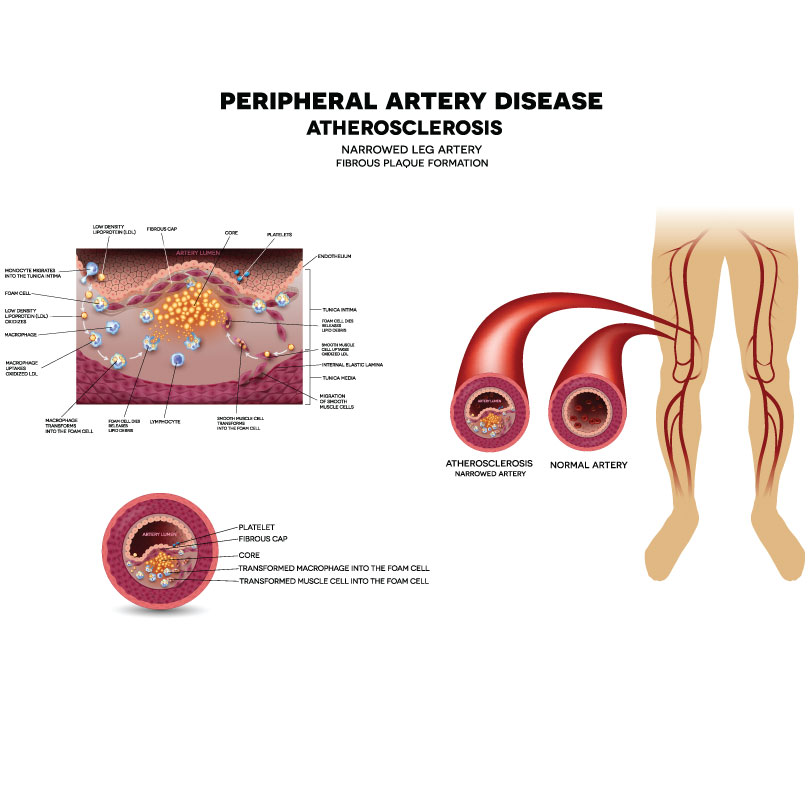Peripheral Artery Disease & Foot Problems
Are You at Risk?
Are you at risk of diabetic complications like diabetic ulcers or peripheral artery disease? Take our quiz and find out!
Education
How does Vascular disease cause Podiatric Complications?
Peripheral Artery Disease (PAD) is a vascular condition where plaque builds up in the arteries. Plaque is made up of fats, cholesterol, and other fibrous substances in the body. Over time, the buildup of plaque causes the arteries to harden and prevents blood flow through the body. This can affect the delivery of oxygen to organs and different parts of your body. PAD most often affects the legs and feet, but can affect any part of the body.
The below illustration demonstrates how peripheral artery disease affects the arteries in the legs and feet.
SYMPTOMS
What are the Symptoms of PAD?
Blocked blood flow to the legs and feet can not only cause pain and numbness, it also increases the risk of contracting infections. Your body requires oxygen to heal injuries and fight infection. Decreased blood flow means decreased oxygen to the site of an injury. In more severe cases, reduced blood flow can lead to gangrene and even amputation.
Many people who have PAD may have no signs or indications of the disease. People who are more at risk for Peripheral Artery Disease include those who are:
- 70 years of age or older
- 50 years of age or older and have a history of smoking or diabetes
- 50 years of age or younger and have more than one risk factor for atherosclerosis
If you have Peripheral Artery Disease, you may experience the following intermittent symptoms:
- Pain or cramping when walking or climbing stairs
- Pain, numbness, heaviness, or aching of leg muscles
- Symptoms may also include cramping in the legs, buttocks, thighs, calves, or feet.
- Weak or absent pulse in the feet
- slow-healing wounds on the legs, ankles, or feet
- pale or bluish-colored skin on the calves or feet
- a lower temperature in one leg compared to the other
- reduced hair growth on the legs
- Poor toenail growth
- erectile dysfunction in men
Care
Advanced Vascular Care
Often times, especially in a diabetic foot the amount of plaque build up in the arteries becomes severe. Outpatient procedures can be performed by a vascular specialist that can allow for the removal of the plaque. The completion of these procedures will allow blood to flow to the diabetic foot resulting in a reduction of foot pain and increased healing in diabetic foot ulcers.
SEEKING HELP
When to See a Podiatrist
Be sure to visit your podiatrist at the first sign that peripheral artery disease may be affecting your feet. If left untreated, PAD can lead to limb amputation and even death. If you have been diagnosed with diabetes, it’s recommended to schedule a routine vascular disease screening to further protect your legs and feet.
Here at MVS Podiatry Associates, our foot doctor will help you determine the best possible treatment option after the initial screening. Contact us today to schedule an appointment.
Your podiatrist has been trained specifically and extensively in the diagnosis and treatment of all manner of foot conditions. This training encompasses all of the intricately related systems and structures of the foot and lower leg including neurological, circulatory, skin, and the musculoskeletal system, which includes bones, joints, ligaments, tendons, muscles, and nerves.
The information on this page is provided by The American Podiatric Medical Association.



